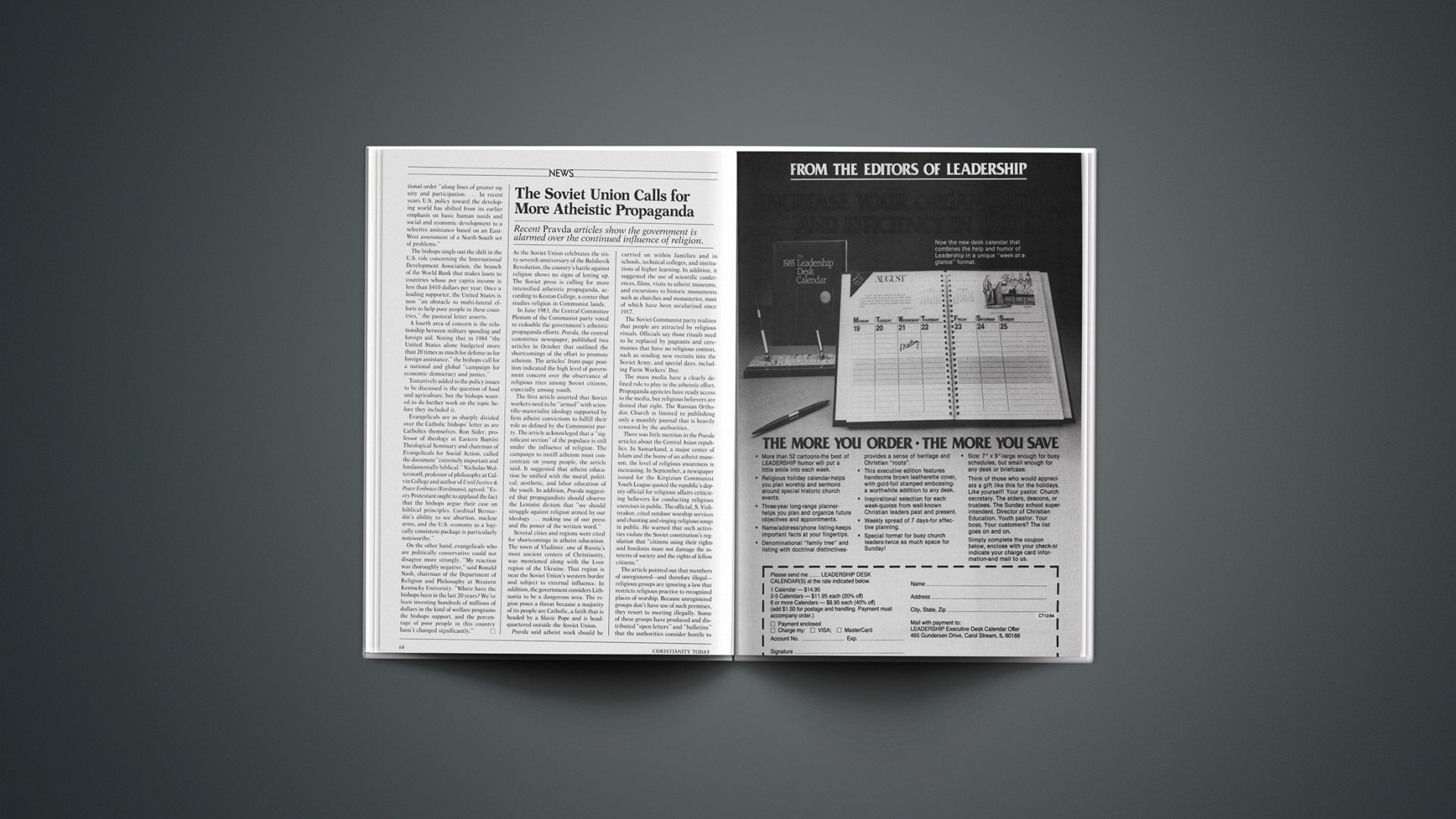Recent Pravda articles show the government is alarmed over the continued influence of religion.
As the Soviet Union celebrates the sixty-seventh anniversary of the Bolshevik Revolution, the country’s battle against religion shows no signs of letting up. The Soviet press is calling for more intensified atheistic propaganda, according to Keston College, a center that studies religion in Communist lands.
In June 1983, the Central Committee Plenum of the Communist party voted to redouble the government’s atheistic propaganda efforts. Pravda, the central committee newspaper, published two articles in October that outlined the shortcomings of the effort to promote atheism. The articles’ front-page position indicated the high level of government concern over the observance of religious rites among Soviet citizens, especially among youth.
The first article asserted that Soviet workers need to be “armed” with scientific-materialist ideology supported by firm atheist convictions to fulfill their role as defined by the Communist party. The article acknowleged that a “significant section” of the populace is still under the influence of religion. The campaign to instill atheism must concentrate on young people, the article said. It suggested that atheist education be unified with the moral, political, aesthetic, and labor education of the youth. In addition, Pravda suggested that propagandists should observe the Leninist dictum that “we should struggle against religion armed by our ideology … making use of our press and the power of the written word.”
Several cities and regions were cited for shortcomings in atheist education. The town of Vladimir, one of Russia’s most ancient centers of Christianity, was mentioned along with the Lvov region of the Ukraine. That region is near the Soviet Union’s western border and subject to external influence. In addition, the government considers Lithuania to be a dangerous area. The region poses a threat because a majority of its people are Catholic, a faith that is headed by a Slavic Pope and is headquartered outside the Soviet Union.
Pravda said atheist work should be carried on within families and in schools, technical colleges, and institutions of higher learning. In addition, it suggested the use of scientific conferences, films, visits to atheist museums, and excursions to historic monuments such as churches and monasteries, most of which have been secularized since 1917.
The Soviet Communist party realizes that people are attracted by religious rituals. Officials say those rituals need to be replaced by pageants and ceremonies that have no religious content, such as sending new recruits into the Soviet Army, and special days, including Farm Workers’ Day.
The mass media have a clearly defined role to play in the atheistic effort. Propaganda agencies have ready access to the media, but religious believers are denied that right. The Russian Orthodox Church is limited to publishing only a monthly journal that is heavily censored by the authorities.
There was little mention in the Pravda articles about the Central Asian republics. In Samarkand, a major center of Islam and the home of an atheist museum, the level of religious awareness is increasing. In September, a newspaper issued for the Kirgizian Communist Youth League quoted the republic’s deputy official for religious affairs criticizing believers for conducting religious exercises in public. The official, S. Vishnyakov, cited outdoor worship services and chanting and singing religious songs in public. He warned that such activities violate the Soviet constitution’s regulation that “citizens using their rights and freedoms must not damage the interests of society and the rights of fellow citizens.”
The article pointed out that members of unregistered—and therefore illegal—religious groups are ignoring a law that restricts religious practice to recognized places of worship. Because unregistered groups don’t have use of such premises, they resort to meeting illegally. Some of these groups have produced and distributed “open letters” and “bulletins” that the authorities consider hostile to the Soviet system and society. Citizens were advised to report any such activities to the authorities.
Official Soviet statements still maintain that religious life is in a general state of decline, according to Keston College. In addition, such statements say most people who attend worship services are elderly women. However, propaganda measures set in motion 18 months ago concentrate on signs of a religious reawakening among young people.










